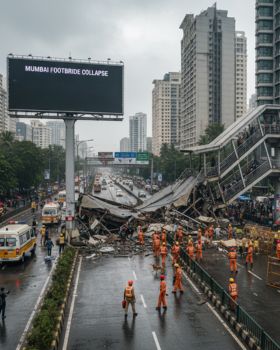Disclaimer:
This article is intended for informational purposes only. It is based on publicly available reports and sources concerning the Hard Rock Hotel collapse in New Orleans. The purpose of this content is to explore general lessons related to contractor oversight, safety practices, and project management. It does not seek to assign blame or liability to any individuals, companies, or organizations involved in the incident. The views expressed are not necessarily those of SHEQ Network. Readers are encouraged to consult official investigation reports and professional safety guidelines for authoritative information.
A Tragedy That Shocked the Nation
On October 12, 2019, the Hard Rock Hotel in New Orleans, United States, partially collapsed while still under construction. The incident claimed three lives and injured dozens, triggering a storm of investigations and raising serious concerns about construction oversight, contractor coordination, and safety management practices.
This tragic event wasn’t just a rare construction mishap—it became a case study in the risks that arise when complex contractor ecosystems are not managed effectively. While we may never be able to definitively say what could have prevented it, it’s important to explore whether better contractor oversight could help reduce the risk of such disasters.
What Happened at the Hard Rock Hotel, New Orleans?
The Hard Rock Hotel New Orleans collapse occurred on the uBest contractor management softwarepper floors of the 18-story building as workers were nearing the final stages of construction. Videos captured by bystanders showed floors pancaking on top of each other in a matter of seconds, sending debris crashing into the streets below.
Initial investigations cited potential design flaws, overstressed support structures, and irregularities in the permitting and inspection process. Several subcontractors were working on-site, making communication and compliance a serious logistical challenge.
The Challenge of Multi-Contractor Projects
Large construction projects like the Hard Rock Hotel involve numerous stakeholders—architects, engineers, general contractors, and multiple subcontractors. This creates a highly fragmented environment where risks can easily fall through the cracks.
In such settings, maintaining clear lines of accountability is critical. Reports following the collapse indicated that communication gaps, lack of centralized oversight, and inadequate documentation may have contributed to the unsafe conditions. A coordinated contractor management approach could help bridge these gaps.
Could Better Contractor Oversight Have Helped?
While it’s speculative to claim any one system could have prevented this tragedy, what we can say with more certainty is that better contractor management could help reduce the likelihood of such failures. When there’s visibility into contractor credentials, safety history, permit status, and task assignments, organizations are better positioned to flag issues early.
Here are a few key areas where stronger contractor oversight could help reduce risk:
- Credential Verification: Ensuring that every contractor and subcontractor is appropriately qualified and trained.
- Documented Communication: A central platform for sharing safety instructions, design changes, and compliance updates helps minimize misunderstandings.
- Work Permit Tracking: Keeping track of issued and expired permits can help ensure only authorized work takes place on-site.
- Audit Trails: In the event of an incident, having accurate logs of who did what and when can be invaluable for investigations.
The Role of Systems in Strengthening Oversight (Without Overpromising)
Let’s be clear—no software alone can guarantee safety or eliminate risk. What robust contractor management systems can do, however, is support organizations in strengthening oversight mechanisms. These platforms serve as tools to organize documentation, streamline communication, and support compliance workflows.
They do not—and should not—replace professional judgment, physical inspections, or government regulation. But by providing an organized framework for managing contractor data, they can help reduce the complexity that often contributes to oversights in large projects.
Learning from Hard Rock: A Cautionary Tale
The Hard Rock Hotel collapse in the United States is now a reference point for discussions around construction risk management. Lawsuits, regulatory scrutiny, and public outcry followed the incident, and the demolition of the unstable structure dragged on for years due to the complexity and dangers involved.
What this case underscores is the importance of proactive risk management—not just reacting to problems but anticipating them. That’s where contractor oversight becomes not just a compliance obligation, but a strategic imperative.
Conclusion: How the Right Tools Could Help Build Safer Futures
Managing contractors efficiently and safely is not just about ticking boxes—it’s about making sure that people go home safe at the end of each day. While nothing can replace proper planning, engineering, and safety culture, the best contractor management software can help support these elements by offering structured systems for compliance, documentation, and oversight.
Solutions like modern contractor management platforms offer features to organize contractor records, track work permits, verify competencies, and support incident documentation—all in one place. While such systems won’t monitor every task or guarantee real-time verification, they can help streamline complex workflows and enhance situational awareness.
If your organization is managing multiple contractors or operating in a high-risk environment, investing in a contractor management solution could help build a stronger foundation for accountability and safety.
🔗 Learn more at sheqnetwork.com and transform the way you manage contractor safety today.
👉 Ready to see it in action? Book your free demo here!
Ready to transform? Contact us today at info@sheqnetwork.com or call us at +353 21 4536034 for a personalized demo!




